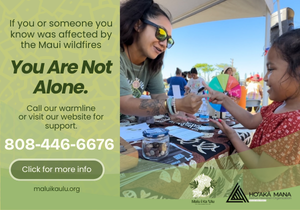Halawa Tsunami

A photo looking east across the flourishing Halawa valley in November of 1938. (Photo submitted by Anakala Pilipo Solatario.)
April 1, 1946 was no fooling for the people of Hawaii, including those of us living in Halawa. I was only six years old when the tsunami hit Molokai, but I remember it well.
To see houses move, including my uncle’s house with the family inside, was incredible. The scariest part was the sound; the sound of the ocean sucking, tress cracking, nails being pulled from the houses, and the rumble of boulders.
There was a phone call Sunday night, March 31, warning us of the ocean after an earthquake north of Alaska. But not understanding what the tsunami warning really meant, we went on with life as usual.
About 10 hours later, at 7 a.m., my mom was walking the beach as she did every morning before heading to the taro patch and noticed the sea was changing. We heard her yelling and before we knew it, we were gathering up treasured photos, the family bible, valuable papers and certificates, and heading to high ground.
What we saw was so strange, the ocean went way out, and we could see fish flopping about on the sand. Then it came back in, not as a huge wave, as one might expect, but slowly. It just flowed, oozed back in and was white and foamy.
The swell continued, surging in and out until water covered most of the valley. The ocean drowned almost 2 miles of the valley floor and was over 100 feet deep. As the ocean receded, we could see the remains of the poi factory, and many families’ houses. The school and church seemed ok, but the taro terraces were full of salt and sand. The good thing was that no lives were lost.
My kupuna had a mo`olelo of a giant battle fought at the base of the eastern cliffs at Kai Wili Beach, near an old heiau. No one knew for sure if the story was true, but after the tsunami receded, we found many bones and skulls in that area. Maybe there was something to our ancestors’ stories.
The day after, we began to clean up the devastation, and I remember the horrible stink from all the rotting fish. We tried to catch some of the live ones for food, but for some reason they tasted different, not good at all. We buried all the dead ones we found.
Next we started to rebuild and repair the homes and structures and flush the salt and sand from the taro patches. The Halawa poi factory was gone forever, and so was the swing bridge. Some families moved, but many stayed and rebuilt the taro patches.
I remember my mom writing me in 1958 or 59 because I was gone. There was a terrible flash flood; she said the whole back-side of the valley was a wall of water. What it did was flatten the taro patches and the dam. Taro farming was never the same after that.
We, by tradition and nature, don’t look back, we look forward. What is past is past, though April 1 always triggers something in my mind and I can still hear the ocean that day.












Don't have a Molokai Dispatch ID?
Sign up is easy. Sign up now
You must login to post a comment.
Lost Password